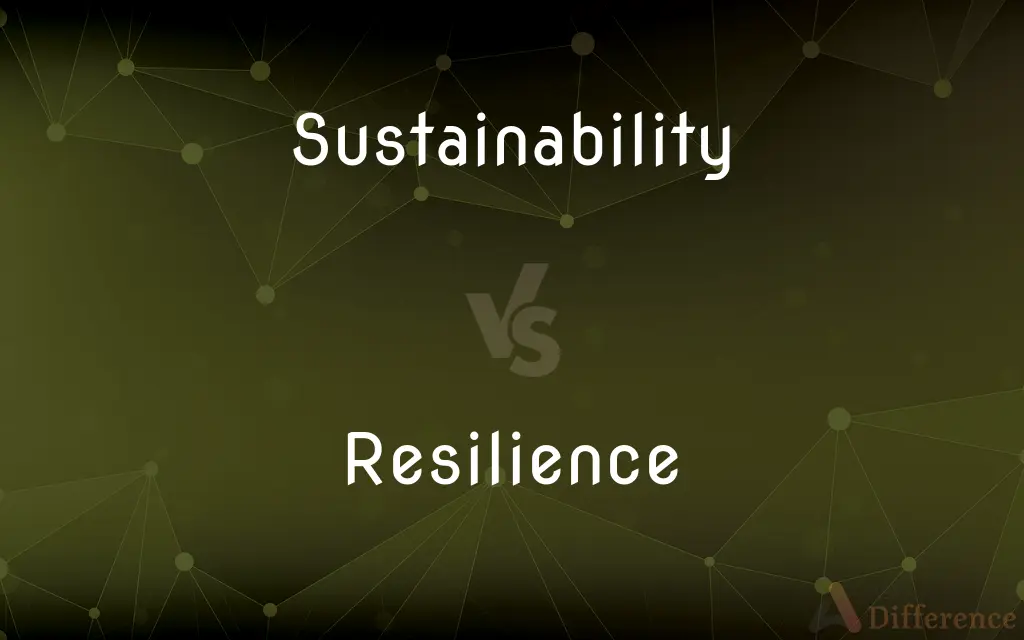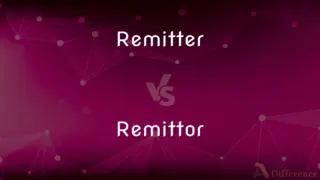Sustainability vs. Resilience — What's the Difference?
Edited by Tayyaba Rehman — By Fiza Rafique — Updated on May 4, 2024
Sustainability focuses on using resources without depleting them for future generations, whereas resilience emphasizes the capacity to recover and adapt to changes or disruptions.

Difference Between Sustainability and Resilience
Table of Contents
ADVERTISEMENT
Key Differences
Sustainability is primarily concerned with meeting the needs of the present without compromising the ability of future generations to meet their own needs. This concept often involves ecological balance, resource efficiency, and long-term environmental health. On the other hand, resilience refers to the ability of a system, community, or individual to withstand, adapt to, and recover from stresses or shocks.
In environmental contexts, sustainability aims to reduce negative human impact and maintain the ongoing health of ecosystems. It often requires proactive measures to manage resources responsibly and promote renewable energy use. Conversely, resilience in these contexts involves preparing and responding effectively to environmental challenges like climate change, natural disasters, and biodiversity loss.
From an economic perspective, sustainability involves developing practices that ensure long-term economic stability and growth without excessive exploitation of resources. Whereas, economic resilience is about the capacity of an economy to absorb impact, recover from recessions, or adapt to new market conditions and technological changes.
In social terms, sustainability seeks to foster equitable access to resources and opportunities, aiming for a balanced society where development benefits are shared. In contrast, social resilience emphasizes strengthening the social fabric, ensuring communities can come together and rebuild after social disruptions or economic crises.
Sustainability initiatives often require long-term planning and commitment to gradual improvements, such as implementing green technologies or sustainable agricultural practices. On the other hand, resilience may require immediate and flexible responses to unexpected changes, emphasizing adaptability and robust contingency planning.
ADVERTISEMENT
Comparison Chart
Focus
Long-term preservation of resources.
Recovery and adaptation to adversity.
Primary Goal
Ensure future generations can meet their needs.
Enhance ability to endure and bounce back from disruptions.
Strategy
Proactive maintenance and careful resource management.
Responsive adaptation and recovery capabilities.
Contexts
Environmental, economic, social.
Environmental, economic, social, personal.
Outcome
Sustainable development, reduced ecological footprint.
Quick recovery, sustained functionality.
Compare with Definitions
Sustainability
Use of resources to meet current needs without compromising future availability.
Investing in solar energy promotes sustainability by reducing dependence on fossil fuels.
Resilience
Ability to recover quickly from difficulties.
Coastal towns build resilience against hurricanes through improved infrastructure.
Sustainability
Policies designed to maintain ecological balance.
Wildlife conservation laws are essential for environmental sustainability.
Resilience
Adaptability in the face of disruption.
Businesses that can pivot to new strategies demonstrate resilience.
Sustainability
Development that minimizes environmental impact.
Building eco-friendly homes is a step toward sustainability.
Resilience
Capacity to maintain core functions during crises.
Emergency plans are crucial for community resilience.
Sustainability
Achieving long-term economic and social stability.
Sustainable business practices ensure profitability without exploiting workers.
Resilience
Flexibility in responding to environmental changes.
Resilient agricultural practices adjust to climate variability.
Sustainability
Practices that do not deplete natural resources.
Sustainable farming methods help preserve soil quality.
Resilience
Strength to withstand economic downturns.
A resilient economy recovers faster from recessions.
Sustainability
Sustainability is the capacity to endure in a relatively ongoing way across various domains of life. In the 21st century, it refers generally to the capacity for Earth's biosphere and human civilization to co-exist.
Resilience
The capacity to recover quickly from difficulties; toughness
The often remarkable resilience of so many British institutions
Sustainability
Capable of being sustained.
Resilience
The ability of a substance or object to spring back into shape; elasticity
Nylon is excellent in wearability, abrasion resistance and resilience
Sustainability
Capable of being continued with minimal long-term effect on the environment
Sustainable agriculture.
Resilience
The ability to recover quickly from illness, change, or misfortune; buoyancy.
Sustainability
The ability to sustain something.
Resilience
The property of a material that enables it to resume its original shape or position after being bent, stretched, or compressed; elasticity.
Sustainability
(ecology) A means of configuring civilization and human activity so that society, its members and its economies are able to meet their needs and express their greatest potential in the present, while preserving biodiversity and natural ecosystems, planning and acting for the ability to maintain these necessary resources for future generations.
Resilience
The mental ability to recover quickly from depression, illness or misfortune.
Sustainability
(business) The ability to sustain a business in the long term, which is a state that is partly dependent on, but broader than, profitability today or in the short term; it involves aspects of a plausible path toward eventual profitability (as applies to a startup) and ecologic sustainability (for example, the long-term dependence of the timber/lumber industry on forest preservation and renewal, or of fisheries on viable fish stocks).
The making of buggy whips is the proverbial exemplar of a business without sustainability in the face of technological change.
Resilience
(physics) The physical property of material that can resume its shape after being stretched or deformed; elasticity.
Sustainability
(civics) The ability to sustain a civic practice or process in the long term, such as democracy, entrepreneurialism, a war effort, or others.
Universal primary and secondary education, without which the sustainability of innovation and entrepreneurialism seems questionable
Resilience
The positive capacity of an organizational system or company to adapt and return to equilibrium after a crisis, failure or any kind of disruption, including: an outage, natural disasters, man-made disasters, terrorism, or similar (particularly IT systems, archives).
Sustainability
The property of being sustainable
Resilience
The capacity to resist destruction or defeat, especially when under extreme pressure.
Resilience
The act of springing back, rebounding, or resiling; as, the resilience of a ball or of sound.
Resilience
The power or inherent property of returning to the form from which a substance is bent, stretched, compressed, or twisted; elasticity[1]; springiness; - of objects and substances.
Resilience
The power or ability to recover quickly from a setback, depression, illness, overwork or other adversity; buoyancy; elasticity[2]; - of people.
Resilience
The mechanical work required to strain an elastic body, as a deflected beam, stretched spring, etc., to the elastic limit; also, the work performed by the body in recovering from such strain.
Resilience
The physical property of a material that can return to its original shape or position after deformation that does not exceed its elastic limit
Resilience
An occurrence of rebounding or springing back
Common Curiosities
How does resilience differ from sustainability?
Resilience focuses on bouncing back and adapting to challenges, while sustainability is about long-term resource management to prevent depletion.
Can a system be sustainable but not resilient?
Yes, a system can be sustainable in terms of resource use but may lack the resilience to adapt quickly to unexpected changes.
What is the main goal of sustainability?
The main goal of sustainability is to ensure that resource use today does not hinder future generations' ability to meet their needs.
Why is resilience important in urban planning?
Resilience is crucial in urban planning to ensure cities can withstand and recover from disasters like floods, earthquakes, or economic shocks.
What are some examples of resilience in the natural world?
Coral reefs that recover from bleaching events and forests that regenerate after wildfires are examples of resilience in nature.
What role do governments play in promoting sustainability and resilience?
Governments play a critical role by setting policies, providing incentives for sustainable practices, and investing in infrastructure that enhances resilience.
Can a community be resilient without being sustainable?
A community might be resilient in the short term, able to quickly recover from specific events, but without sustainable practices, it might not manage resources well enough to ensure long-term viability.
How do sustainable practices contribute to resilience?
Sustainable practices can contribute to resilience by building healthier ecosystems and societies that are better equipped to handle disruptions.
How can businesses incorporate both sustainability and resilience?
Businesses can incorporate both by adopting sustainable practices that also enhance their ability to adapt to market changes and environmental conditions.
What are the economic benefits of sustainability?
Sustainability can lead to economic benefits such as reduced operational costs, increased productivity through better resource management, and access to new markets driven by consumer preference for sustainable products.
How does technology influence sustainability and resilience?
Technology advances sustainability by improving efficiency and creating alternatives to harmful practices, while it enhances resilience by providing tools that predict, respond to, and recover from disruptions.
How do sustainable and resilient approaches differ in response to climate change?
Sustainable approaches aim to mitigate climate change through reduced emissions and sustainable energy use, whereas resilient strategies focus on adapting infrastructures and communities to live with the impacts of climate change.
How do individuals contribute to both sustainability and resilience?
Individuals contribute by adopting sustainable habits like recycling and energy conservation, and by supporting community resilience through local initiatives and preparedness activities.
What is an example of a sustainability failure?
Overfishing is an example where the lack of sustainable practices leads to the depletion of fish stocks, affecting ecological balance and future industry sustainability.
Share Your Discovery

Previous Comparison
Jazz vs. Contemporary
Next Comparison
Remitter vs. RemittorAuthor Spotlight
Written by
Fiza RafiqueFiza Rafique is a skilled content writer at AskDifference.com, where she meticulously refines and enhances written pieces. Drawing from her vast editorial expertise, Fiza ensures clarity, accuracy, and precision in every article. Passionate about language, she continually seeks to elevate the quality of content for readers worldwide.
Edited by
Tayyaba RehmanTayyaba Rehman is a distinguished writer, currently serving as a primary contributor to askdifference.com. As a researcher in semantics and etymology, Tayyaba's passion for the complexity of languages and their distinctions has found a perfect home on the platform. Tayyaba delves into the intricacies of language, distinguishing between commonly confused words and phrases, thereby providing clarity for readers worldwide.













































